Abstract
To study the structure and distribution characteristics of the phytoplankton community in the Huaihe River Basin, Yangtze River Basin, and Taihu Lake Basin in Jiangsu Province, 126 sampling sites were set up in 35 rivers in the region, and samples were collected during the wet season (August–September) in 2023. Based on the monitoring results of phytoplankton, the study selected 20 candidate indicators and conducted range screening, discriminative ability analysis, and correlation analysis. Finally, seven core indicators were determined to construct the Phytoplankton Biological Integrity Index (P-IBI) evaluation system. The rating standards were determined by the ratio method, and the phytoplankton integrity of Jiangsu Province was evaluated. The differences were analyzed. As the results showed, the overall health status of rivers in Jiangsu Province was general. From the point of view of the basin scope, the Huaihe River Basin and the Yangtze River Basin were in sub-healthy state, and the Taihu Lake Basin was general. There were significant differences in the phytoplankton density community structure in the Yangtze River, Huaihe River, and Taihu Lake Basins. Phytoplankton integrity was positively correlated with total nitrogen and nitrate nitrogen, but not with other environmental factors. Nitrogen is the main factor affecting the integrity of river phytoplankton in Jiangsu Province.
1. Introduction
The Index of Biotic Integrity (IBI) was first introduced by Karr [] in 1981. Initially, IBI research primarily focused on fish communities but later expanded to encompass large benthic invertebrates, zooplankton, phytoplankton, and periphyton [,]. Unlike single-factor evaluations based solely on physical and chemical parameters or biodiversity indices, the IBI integrates the composition and structure of biological communities, thereby providing more comprehensive and nuanced evaluation results [,].
Phytoplankton serve as primary producers in aquatic ecosystems and play a pivotal role in energy flow, material cycling, and information transmission. Their high sensitivity to external changes makes them ideal indicator species or model organisms for ecological studies [,]. In 2006, Lacouture et al. [] proposed the Phytoplankton Index of Biotic Integrity (P-IBI) based on their study of Chesapeake Bay and its tidal tributaries. First, they divided the habitat into least impaired and impaired areas. Then, they selected indicators, including community structure composition, growth characteristics, and diversity indices to construct the evaluation system, defined scoring criteria, and calculated the P-IBI for the region. In recent years, the P-IBI has been widely adopted in water ecological health assessments [].
Jiangsu Province, located in the lower reaches of the Yangtze River and Huai River, boasts a developed economy and three major river basins: the Huai River Basin, Yangtze River Basin, and Taihu Lake Basin. These regions are characterized by numerous water systems and dense river networks. Numerous scholars have conducted research using the P-IBI. For instance, Cai Kun et al. [] calculated the Phytoplankton Biotic Integrity Index in Taihu Lake during winter and found that the evaluation results were largely consistent with the lake’s water quality. Tan et al. [] performed a comprehensive study of the water ecosystem in the upper reaches of the Yangtze River using the P-IBI and concluded that the four-point system and ratio method could more accurately classify evaluation grades, leading to more precise results. Li et al. [] further incorporated human disturbance factors into P-IBI analysis, suggesting that soil erosion caused by human activities could influence the population structure and biotic integrity of phytoplankton to some extent. Nevertheless, most of the existing studies are limited to a single river or lake or a specific river basin. The spatial scale of these studies is relatively small, and there are few comprehensive studies covering multiple river basins. There is also a lack of comparative studies among different river basins. To comprehensively assess the water ecological conditions of rivers in the Huai River, Yangtze River, and Taihu Lake Basins in Jiangsu Province, this study draws on domestic and international research to construct a P-IBI analysis framework for phytoplankton in Jiangsu’s rivers. This framework explores the distribution characteristics of the P-IBI and its correlation with environmental factors, providing theoretical support and data references for the governance and protection of rivers in Jiangsu Province.
2. Materials and Methods
2.1. Sampling Point Layout
Considering the vast number and considerable variability of rivers in Jiangsu Province, 35 representative provincially managed rivers were selected from the three major basins—the Huaihe River Basin (HH), Yangtze River Basin (CJ), and Taihu Lake Basin (TH). A total of 126 sampling points were systematically distributed across these rivers to ensure even coverage. The locations of the sampling points are presented in Figure 1.

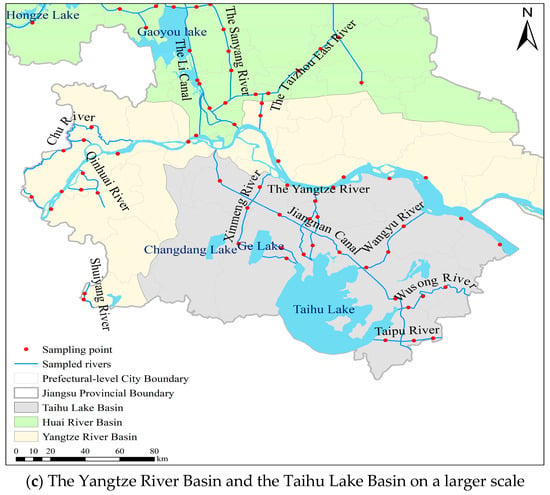
Figure 1.
Sampling point layout.
2.2. Sample Collection and Processing
During the flood season of 2023 (August), samples of phytoplankton were collected and identified. According to the “Research Methods of Freshwater Plankton”, a No. 25 plankton net with a mesh diameter of 64 μm was used to collect phytoplankton from the river, and the samples were fixed with 4% formaldehyde solution to ensure their morphological stability []. Using a 1 L water sampling device, phytoplankton samples were collected at the surface (0.5 m below the water surface), in the middle (1/2 of the water depth), and at the bottom layer (0.5 m above the river bottom) of the river. The three samples were mixed thoroughly, then 1 L of the mixed sample was taken, and 15 mL of Lugol’s solution was added for secondary fixation. After standing for 48 h, the supernatant was extracted using the siphon principle and concentrated to 30–50 mL, followed by microscopic examination []. The microscopic examination of phytoplankton was based on “Flora of Freshwater Algae in China” [] and the “Illustrated Atlas of Common Algae in Inland Waters of China” [], etc., and identified to the species level under a 10 × 40 magnification microscope, and the conversion of biomass, density, and other indicators was carried out.
2.3. Data Processing and Analysis
2.3.1. Diversity Index
The Shannon–Wiener index (H) [], Margalef index (D) [], and Pielou index (J) [] were utilized to characterize the community structure of phytoplankton in rivers of Jiangsu Province. The corresponding calculation formulas are presented as follows:
In the formulas, S represents the number of phytoplankton species at the sampling point, N represents the total cell abundance of all phytoplankton at the sampling point, and Pi represents the proportion of the i-th species.
2.3.2. Dominant Species
The dominance degree (Y) was calculated to evaluate the dominant species of phytoplankton, and the calculation formula is as follows:
In the formula, N represents the total number of all individuals, ni represents the number of individuals of the i-th phytoplankton species, and fi represents the frequency of occurrence of the i-th phytoplankton species. Species with Y ≥ 0.02 are considered dominant species.
2.4. Construction of the Phytoplankton Integrity Evaluation System
The application of the Biological Integrity Index for evaluation first involved categorizing sampling points into reference points and impaired points. Points with a Shannon–Wiener index H ≥ 3 and a Margalef index D ≥ 3 were designated as reference points.
Candidate indicators were preliminarily identified based on existing research and the characteristics of the phytoplankton community within the sampling area [,]. A preliminary screening was conducted according to the distribution range of candidate indicator parameters, removing those with excessively wide distributions and large standard deviations. Box plots were utilized for discriminant ability analysis to evaluate the overlap between reference points and impaired points, retaining indicators with an interquartile range (IQ) ≥ 2. Correlation analysis was performed on the remaining indicators. If the candidate indicator parameters followed a normal distribution, Pearson correlation tests were conducted; otherwise, Spearman correlation tests were applied. For indicator parameters with a correlation coefficient |R| > 0.75, one of the two indicators was retained based on its greater representativeness.
After screening, the ratio method was employed to assign scores to the core parameters [], constructing a phytoplankton biological integrity evaluation system (P-IBI) applicable to the Yangtze River, Huai River, and Taihu Lake Basins in Jiangsu Province.
For core parameters that decreased with increasing disturbance, the scoring calculation formula was as follows:
For the core parameters that increased with the rise in interference, the scoring calculation formula was as follows:
In the formula, Q represents the quantile.
If the calculated score was greater than 1, it was recorded as 1. The sum of the scores of each core parameter was the Phytoplankton Biological Integrity Index. The 25th percentile of the reference point was taken as the best expected value to determine the evaluation criteria []. Values greater than the 25th percentile were evaluated as “healthy”, and the range of values less than or equal to the 25th percentile was divided into four equal parts and evaluated as “sub-healthy”, “average”, “poor”, and “very poor”, respectively, to determine the evaluation criteria for the Phytoplankton Biological Integrity Index.
3. Results and Analysis
3.1. Characteristics of Phytoplankton Community Structure
In this study, a total of 215 species belonging to 93 genera across 8 phyla of phytoplankton were identified. Among these, Chlorophyta exhibited the highest diversity with 38 genera and 85 species, accounting for 39.25%. Bacillariophyta followed with 27 genera and 57 species (26.64%), while Euglenophyta comprised 5 genera and 33 species (15.42%). Cyanobacteria included 13 genera and 24 species (11.21%). The remaining phyla—Cryptophyta, Dinophyta, Chrysophyta, and Xanthophyta—together consisted of 11 genera and 16 species, representing 7.84% of the total (Figure 2). The dominant species identified in this study were Phormidium irriguum, Aphanizomenon flos-aquae, Chlorella vulgaris, Klebsormidium subtile, and Phormidium corium.
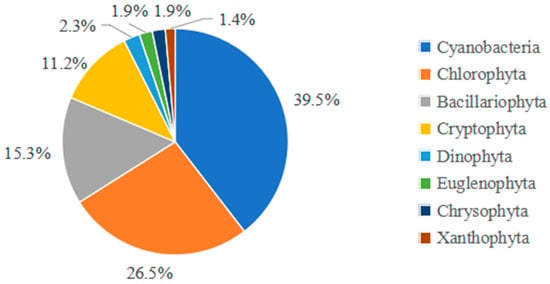
Figure 2.
Composition of phytoplankton species.
As illustrated in Figure 3, the Huai River Basin exhibited a significantly higher number of phytoplankton species compared to the Yangtze River Basin and Taihu Lake Basin. This was primarily due to the pronounced dominance of Chlorophyta and Euglenophyta species. The community structures of phytoplankton in the three basins were relatively similar, with eight phyla identified in each basin. Among these, Bacillariophyta and Chlorophyta dominated, followed by Euglenophyta and Cyanobacteria. The remaining four phyla of algae contributed only a negligible proportion to the overall composition.
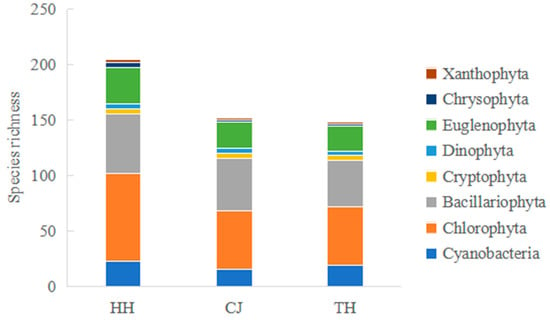
Figure 3.
Community structure of phytoplankton species.
The average density of phytoplankton in the rivers of Jiangsu Province during the wet season of 2023 was cells/L. Specifically, Cyanobacteria exhibited the highest density at cells/L, accounting for 67.61% of the total density. Chlorophyta ranked second, with a density of cells/L, contributing 21.90%. Bacillariophyta followed with cells/L, representing 7.39%, and the remaining phyla collectively accounted for 3.09% (Figure 4). The phytoplankton community structure was mainly composed of Cyanobacteria, green algae, and chrysophytes, presenting typical Cyanobacteria–green algae–chrysophytes characteristics. Similar to the species richness pattern, the Huai River Basin demonstrated significantly higher phytoplankton densities compared to the Yangtze River Basin and Taihu Lake Basin (Figure 5). However, notable differences were observed in the density-based community structures among the three basins. Cyanobacteria densities in the Huai River Basin were markedly higher than those in the other basins and dominated the local community. In contrast, Cryptophyta densities in the Yangtze River Basin were relatively higher compared to the other basins, primarily driven by Cryptomonas ovata and Cryptomonas erosa.

Figure 4.
Composition of phytoplankton density.
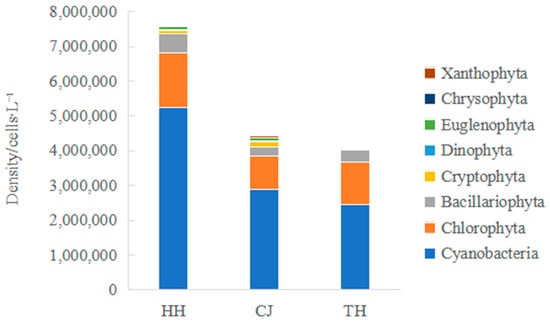
Figure 5.
Community structure of phytoplankton.
The results of the one-way ANOVA test revealed that while there were variations in the spatial distribution of phytoplankton biomass and density, these differences were not statistically significant (p > 0.05). Overall, phytoplankton biomass exhibited a decreasing trend from north to south and from west to east, with local maxima observed in the Huai River Basin and Taihu Lake Basin (Figure 6a). The spatial distribution of phytoplankton density was largely consistent with that of biomass, showing the highest values in the northern region and locally elevated levels in the central and southern areas. Notably, multiple local maxima were identified within the Huai River Basin (Figure 6b).
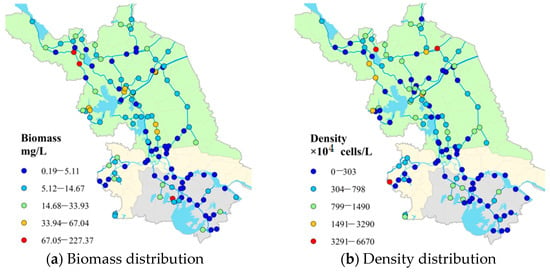
Figure 6.
Distribution characteristics of phytoplankton.
3.2. Distribution Characteristics of Phytoplankton Diversity
During the investigation period, the Shannon–Wiener index (H), Margalef index (D), and Pielou index (J) of phytoplankton in Jiangsu Province exhibited significant spatial heterogeneity. Their respective distribution ranges were 0.51–3.43 for H, 0.55–4.97 for D, and 0.19–0.93 for J. The spatial distribution maps are presented in Figure 7. The H index showed a pattern of being higher in the central region and locally elevated in the northern and southern regions, with the highest value recorded in the Chu River of the Yangtze River Basin and the lowest in the Jiangnan Canal of the Taihu Lake Basin. The D index generally followed a similar distribution trend to the H index but exhibited more pronounced variation patterns, with its highest value observed in the Tongyu River of the Huai River Basin and the lowest in the Central Canal. The Pielou index displayed a more scattered distribution, with generally higher values in the southeastern region compared to the northwestern region. Its highest value was recorded in the Feihe River of the Huai River Basin, while the lowest occurred in the Jiangnan Canal of the Taihu Lake Basin.
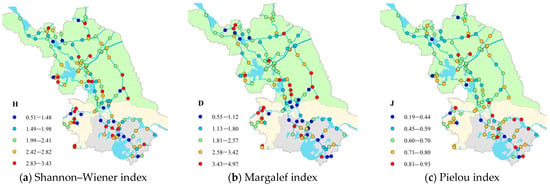
Figure 7.
Distribution characteristics of phytoplankton diversity index.
3.3. Construction of Phytoplankton Integrity Index
3.3.1. Selection of Reference Points and Impaired Points
Based on the Shannon–Wiener index and Margalef index, 126 sampling points were classified into 12 reference points and 114 impaired points. The reference points were distributed in the Huai River, Pi-Cang Flood Diversion Channel, Tongyu River, and Jinbao Waterway in the Huai River Basin, the Chu River, Shuiyang River, and Qinhuai River in the Yangtze River Basin, and Xinmeng River in the Taihu Lake Basin.
3.3.2. Screening of Candidate Indicators
Twenty candidate indicators were initially selected, as shown in Table 1. Indicators Z6 and Z13, which had a relatively scattered distribution and a large standard deviation, were excluded.

Table 1.
P-IBI candidate indicators and interference.
3.3.3. Discrimination Ability Analysis
Discrimination ability analysis was conducted based on the box plot, as shown in Figure 8. IQ represents the overlapping situation of the two boxes—IQ = 3: the boxes do not overlap, IQ = 2: the boxes partially overlap, but the median lines of both boxes are not within each other’s boxes, IQ = 1: only the median line of one box is within the other box, and IQ = 0: the median lines of both boxes are within each other’s boxes. If the IQ value is ≤1, it indicates that the dispersion of this indicator at the reference point and the damaged point is similar, and it cannot be used for discrimination and evaluation, so it is excluded. By comparing the overlap between the reference point and the damaged point boxes. The Z1, Z2, Z3, Z4, Z5, Z7, Z8, Z10, Z18, Z19, and Z20 indicators with IQ ≥ 2 were retained.


Figure 8.
Results of discriminant ability analysis of the P-IBI candidate indicators.
3.3.4. Correlation Analysis
Since the candidate indicator parameters did not conform to the normal distribution, the Spearman analysis was used to examine the correlation. The results are shown in Table 2. Based on the analysis of the results, Z1, Z5, Z10, and Z19 were excluded, and Z2, Z3, Z4, Z7, Z8, Z18, and Z20 were retained as the final core indicators.

Table 2.
Correlation analysis results of the P-IBI candidate indicators.
3.3.5. Determination of Evaluation Criteria
This paper adopted the ratio method to calculate the final scores of the core parameters selected, as shown in Table 3. According to the calculation Equations (5) and (6) mentioned earlier, if the calculated value is greater than 1, it is recorded as 1. The scores of each core biological parameter were accumulated to obtain the Phytoplankton Biological Integrity Index of each sampling point.

Table 3.
Eigenvalue distribution of core parameters.
The 25th percentile of the reference point was used as the optimal expected value to establish five evaluation levels, as detailed in Table 4.

Table 4.
Evaluation criteria for the P-IBI.
3.4. Evaluation Results of Phytoplankton Integrity
Based on the evaluation criteria, the integrity of phytoplankton in the Huaihe River, the Yangtze River, and the Taihu Lake Basin in Jiangsu Province was evaluated. As there are multiple sampling points for each river, the average value of multiple points was taken as the Phytoplankton Integrity Index of the river. The evaluation results are shown in Table 5.

Table 5.
P-IBI evaluation of rivers.
The P-IBI assessment indicated that the overall average score for the ecological health of rivers in Jiangsu Province was 3.875, which falls within the “General” category. Specifically, 12 rivers were classified as being in a “Sub-healthy” state, while 20 rivers were rated as “General”. Notably, the Pi-Cang Flood Diversion Channel and Jinbao Waterway performed better and were categorized as healthy, whereas the Xintongyang Canal received a relatively poor evaluation. From a basin perspective, the phytoplankton integrity assessments revealed sub-healthy conditions in both the Huai River Basin and the Yangtze River Basin, whereas the Taihu Lake Basin was assessed as “General”. In terms of water body health status, ranked from best to worst, the order was Huai River Basin (3.929), Yangtze River Basin (3.896), and Taihu Lake Basin (3.701).
3.5. Correlation Between P-IBI Index and Environmental Factors
The environmental data of rivers in Jiangsu Province during the flood season of 2023 are presented in the Table 6.

Table 6.
Environmental data of rivers.
Pearson correlation analysis was conducted on P-IBI and environmental factors, and the results are shown in Table 7. It can be seen from the table that the P-IBI value of the river was significantly positively correlated with TN and NO3−-N and had no obvious correlation with other environmental factors.

Table 7.
Correlation analysis of P-IBI and environmental factors.
4. Discussion
4.1. Rationality of P-IBI Evaluation Results
As a typical comprehensive Biological Indicator Index, the Biological Integrity Index can effectively represent the degree of external environmental disturbances and quantitatively characterize water ecological health status in numerical form []. Compared with fish and large invertebrates, phytoplankton exhibit shorter regeneration times and lifecycles, making them more sensitive to changes in water environmental factors and enabling them to respond more rapidly to human disturbances. Consequently, using the Phytoplankton Integrity Index for evaluation allowed for a more precise reflection of the current water ecological health status under study [,].
Based on the phytoplankton monitoring results from rivers in Jiangsu Province during the flood season of 2023, Cyanobacteria were found to dominate, followed by green algae and diatoms, forming a Cyanobacteria–green algae–diatom algal structure. Gianbattista Bussi et al. [] concluded that water bodies dominated by Cyanobacteria, green algae, and diatoms are typically moderately polluted, which aligns well with the findings of the phytoplankton biological integrity evaluation. The P-IBI evaluation results indicated that the Huai River and Yangtze River Basins were in a sub-healthy state, while the Taihu Lake Basin was rated as “General”, consistent with the overall water quality conditions. Therefore, the use of the P-IBI for assessing water ecological health is both referenceable and feasible.
4.2. Spatial Distribution Characteristics of P-IBI in Rivers of Jiangsu Province
The spatial distribution characteristics of the P-IBI for phytoplankton in rivers of Jiangsu Province are presented in Figure 9. A one-way ANOVA was conducted on the P-IBI at each sampling point, and the results indicated no significant difference (p = 0.703 > 0.05). However, overall, the Phytoplankton Integrity Index exhibited spatial heterogeneity, with better phytoplankton integrity observed in the central region compared to the northern and southern regions. This trend aligns with the distribution patterns of phytoplankton species and density: Huai River Basin > Yangtze River Basin > Taihu Lake Basin.
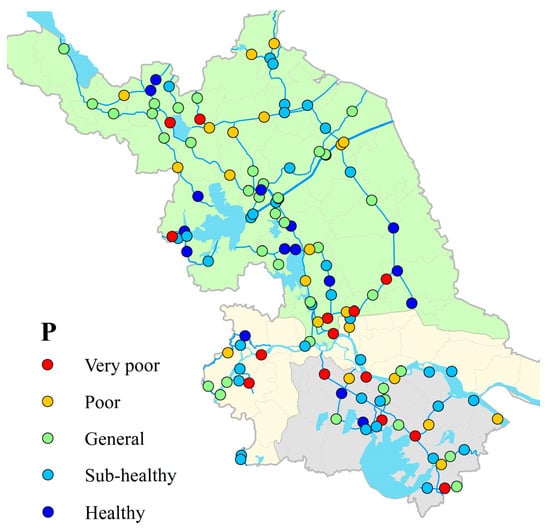
Figure 9.
Spatial distribution of the P-IBI.
In the Huai River Basin, the average P-IBI was 3.929, indicating a sub-healthy state. The basin contains 25 rivers, among which the Pi-Cang Flood Diversion Channel and Jinbao Waterway were rated as healthy, while the Xintongyang Canal had a poor evaluation result. The remaining 9 rivers were in a sub-healthy state, and 13 rivers had an average evaluation result. The Xintongyang Canal is an artificial waterway used for water diversion, irrigation, and navigation. Its water quality is poor due to severe nutrient and organic oxygen-consuming pollution, coupled with low dissolved oxygen concentrations, leading to poor phytoplankton integrity []. Generally, phytoplankton integrity in the southern part of the basin is better than in the northern part, likely because lakes, such as Hongze Lake, Gaoyou Lake, and Baima Lake, exist in the south, where numerous sluices and dams create weak hydrodynamic conditions that promote nutrient deposition, favoring the growth of phytoplankton, particularly Cyanobacteria. This finding is consistent with the community structure, showing much higher Cyanobacteria densities compared to other groups [].
In the Yangtze River Basin, the average P-IBI was 3.896, indicating a sub-healthy state. Phytoplankton integrity showed a west-high, middle-low distribution pattern. Given that most sampling points are located in Nanjing and along the Yangtze River, it is inferred that phytoplankton integrity is higher in the Nanjing area than in the Yangtze River itself. In recent years, Nanjing has implemented several water environment improvement measures, achieving the best water quality monitoring performance in the province and maintaining good ecological conditions, which are conducive to phytoplankton growth. In contrast, most sections of the Yangtze River in Jiangsu Province are artificially constructed, dominated by industrial production and port terminals, resulting in relatively simple habitats. Additionally, frequent ship traffic can cause an increase in the Froude number of water depth (Fr), which restricts the survival and reproduction of phytoplankton []. The eastern section, located in Suzhou, is one of the key areas for water ecological protection, explaining why its P-IBI evaluation result was better than that of the middle section.
In the Taihu Lake Basin, the average P-IBI was 3.701, indicating a “General” state. Among the rivers in this basin, only Xinmeng River achieved a sub-healthy P-IBI evaluation result, surpassing the other five rivers. The Xinmeng River Project is a critical component of national efforts to improve the Taihu Lake water environment and serves as one of the water environment capacity enhancement and drainage channel projects. It promotes water circulation in Taihu Lake and improves surrounding water environmental conditions, creating favorable conditions for phytoplankton growth.
Analysis of similarities (ANOSIM) is a non-parametric test method based on the permutation test and rank sum test, used to test whether there is a significant difference between groups. We conducted pairwise ANOSIM on the phytoplankton density in the Huai River, Yangtze River, and Taihu Lake Basins, and the results are shown in Figure 10. When the ANOSIM result showed p < 0.05, there was a significant difference between the groups. The results indicated that there were significant differences in the phytoplankton density community structure between the Huai River Basin and the Yangtze River Basin (p = 0.011), and between the Yangtze River Basin and the Taihu Lake Basin (p = 0.043).

Figure 10.
ANOSIM results of interbasin density.
Similarity percentage (SIMPER) analysis is a statistical method used to identify the key contributing species that account for the significant differences between different groups of communities. It can calculate the mean similarity among samples within each group based on the Bray–Curtis similarity index and reveal the contribution of each variable to the overall differences.
The SIMPER analysis was used to determine the contribution rates of different algae to the differences in the Huaihe River and Yangtze River Basins. The top 10 species with the highest contribution rates are presented in Table 8.

Table 8.
The main contributing species of phytoplankton density difference between Huaihe River and Yangtze River Basins.
The contribution rates of different algae to the differences in the Yangtze River and Taihu Lake Basins were analyzed using SIMPER analysis, and the results are shown in Table 9.

Table 9.
The main contributing species of phytoplankton density difference between Yangtze River and Taihu Lake Basins.
By comparing the results of the SIMPER analysis between the two groups, it was evident that the species primarily contributing to the differences in phytoplankton density community structure were largely similar. Among the top 10 species contributing to these differences, all belonged to either Cyanobacteria or Chlorophyta phyla, with seven from Cyanobacteria and three from Chlorophyta. Notably, except for Limnospira platensis and Merismopedia tranquilla in the Yangtze River and Huai River Basins, as well as Eudorina elegans and Chroococcus cohaerens in the Yangtze River and Taihu Lake Basins, the remaining eight species were identical. This similarity may stem from the comparable phytoplankton density community structures observed in the Huai River and Taihu Lake Basins (p = 0.446). With the exception of a few species, the densities of other species generally followed the trend Huai River Basin > Yangtze River Basin, and Taihu Lake Basin > Yangtze River Basin. Based on these findings, it can be inferred that the growth conditions of phytoplankton in the Yangtze River Basin were less favorable compared to those in the Huai River and Taihu Lake Basins. This disparity was likely attributable to the adverse impacts of high-intensity human activities, such as industrial development and shipping along the Yangtze River, which have negatively influenced the health of rivers within this basin.
4.3. Relationship Between P-IBI and Environmental Factors
The distribution and succession of the phytoplankton community structure are the result of interactions among various environmental factors, and their changes can serve as indicators of water environmental conditions []. Previous studies have demonstrated that environmental factors, such as N, P, CODMn, pH, WT, TDS, and flow velocity, influence both the composition and growth of phytoplankton communities [,]. Based on the correlation analysis results between the P-IBI and environmental factors presented in this study, the P-IBI values of rivers in Jiangsu Province exhibited significant positive correlations only with total nitrogen (TN) and nitrate nitrogen (NO3−-N). Within a certain range, the complexity of the phytoplankton community structure increased with rising concentrations of TN and NO3−-N, findings consistent with those reported by Zhang Shunting et al. [] for Yangcheng Lake. This suggests that there were similarities in the relationships between phytoplankton integrity and environmental factors across different aquatic environments.
In contrast to TN and NO3−-N, the correlations between P-IBI and other environmental factors were relatively weak. This may be attributed to the extensive study area and numerous sampling points, which resulted in relatively stable phytoplankton community compositions that were less susceptible to significant impacts from individual environmental factors. Additionally, the scouring effects of rivers likely exerted some influence on phytoplankton growth []. More critically, rapid economic development, large populations, and urbanization-related human activities within the study region of Jiangsu Province disrupted phytoplankton habitats, thereby affecting the diversity and integrity of phytoplankton communities. For instance, the Taihu Lake Basin, being more economically developed than the Huaihe River and Yangtze River Basins, exhibited poorer evaluations of phytoplankton integrity, supporting the aforementioned inference. Consequently, these multifaceted factors may obscure the relationship between P-IBI and water quality indicators, such as nutrient levels.
5. Conclusions
- (1)
- In this study, 20 candidate indicators were evaluated through distribution range tests, discriminant ability analysis, and correlation analysis. Ultimately, seven indicators—Z2, Z3, Z4, Z7, Z8, Z18, and Z20—were selected as core indicators to construct the biological integrity assessment system for phytoplankton in rivers of Jiangsu Province.
- (2)
- The P-IBI assessment results indicated that the overall biological integrity of phytoplankton in rivers of Jiangsu Province was “General” during the flood season. Specifically, the Huai River Basin and Yangtze River Basin were in a sub-healthy state, while the Taihu Lake Basin had a “General” evaluation result. The health status could be ranked as follows: Huai River Basin > Yangtze River Basin > Taihu Lake Basin.
- (3)
- During the flood season, significant differences in the density community structure of phytoplankton were observed between the Yangtze River and Huai River Basins, as well as between the Yangtze River and Taihu Lake Basins. This suggests that high-intensity human activities, such as industrial development and shipping, along the Yangtze River have exerted adverse effects on the community structure of phytoplankton.
- (4)
- During the flood season, the P-IBI exhibited significant positive correlations with total nitrogen (TN) and nitrate nitrogen (NO3−-N), but weak correlations with other water environmental factors. Nitrogen elements were identified as the primary environmental factors influencing the biological integrity of phytoplankton. Both water environmental factors and human activities can directly or indirectly impact the biological integrity and community distribution of phytoplankton, thereby affecting the ecological health of water bodies.
Author Contributions
Conceptualization, Y.Z.; methodology, Y.Z. and L.L.; software, Y.Z.; validation, Y.Z. and L.L.; formal analysis, Y.Z.; data curation, Y.Z., L.L., Y.J. and C.Y.; supervision, Y.Z., L.L. and Y.J.; writing—original draft preparation, Y.Z.; writing—review and editing, Y.Z., L.L. and Y.J.; visualization, Y.Z. and C.Y. All authors have read and agreed to the published version of the manuscript.
Funding
National Natural Science Foundation of China: (1) Research on the Stress Response and Control Mechanism of Phytoplankton in the Damaged Ecosystem of Yangcheng Lake (52170160). (2) Research on the Stress Response Mechanism of Phytoplankton in the Jiangsu Section of the Yangtze River under Changing Habitats (51879085).
Data Availability Statement
All data are included in the article.
Acknowledgments
The authors want to thank the editor and anonymous reviewers for their valuable suggestions for improving this paper.
Conflicts of Interest
The authors declare no conflicts of interest.
References
- Karr, J.R. Assessment of Biotic Integrity Using Fish Communities. Fisheries 1981, 6, 21–27. [Google Scholar] [CrossRef]
- Liu, H.Q.; Li, X.D.; Yang, Q.; Chao, X.; Yang, S.X.; Yan, B.J.; Ba, S. Evaluation on Water Ecological Health in Middle and Upper Reaches of the Yarlung Zangbo River Based on Phytoplankton-Index of Biotic Integrity. J. Arid. Land Resour. Environ. 2023, 37, 109–117. [Google Scholar]
- Yu, M.F.; Liu, J.Z.; Xia, D.; Xia, W.; Zhou, Z.; Yuan, H.; Xiao, Y.Q.; Chen, D.X.; Niu, Y.D.; Tang, J. Ecosystem Health Evaluation in Hengling Lake Based on the Biological Integrity of Phytoplankton. Hunan For. Sci. Technol. 2022, 49, 35–43. [Google Scholar]
- Thakur, R.K.; Jindal, R.; Singh, U.B.; Ahluwalia, A.S. Plankton diversity and water quality assessment of three freshwater lakes of Mandi (Himachal Pradesh, India) with special reference to planktonic indicators. Environ. Monit. Assess. 2013, 185, 8355–8373. [Google Scholar] [CrossRef]
- Liu, L.F.; Zhou, X.H.; Gao, J.; Liu, M.Q.; Pan, X.B.; He, L.; Cai, S.Y.; Zhao, Y.J.; Pan, C.; Wang, H.; et al. Phytoplankton Community Structure and Trophic Status Evaluation in Dajiuhu Wetland of Shennongjia Alpine. J. Lake Sci. 2018, 30, 417–430. [Google Scholar]
- Luo, M.N. Distribution Characteristics of Phytoplankton Functional Groups and Biological Evaluation of Water Quality in Taihu Basin; Master’s Thesis, Harbin Normal University, Harbin, China, 2022. [Google Scholar]
- Cabecinha, E.; Cortes, R.; Cabral, J.A.; Ferreira, T.; Lourenço, M.; Pardal, M.Â. Multi-scale approach using phytoplankton as a first step towards the definition of the ecological status of reservoirs. Ecol. Indic. 2009, 9, 240–255. [Google Scholar] [CrossRef]
- Lacouture, R.V.; Johnson, J.M.; Buchanan, C.; Marshall, H.G. Phytoplankton Index of Biotic Integrity for Chesapeake Bay and Its Tidal Tributaries. Estuaries Coasts 2006, 29, 598–616. [Google Scholar] [CrossRef]
- Riato, L.; Leira, M.; Della Bella, V.; Oberholster, P.J. Development of a diatom-based multimetric index for acid mine drainage impacted depressional wetlands. Sci. Total Environ. 2018, 612, 214–222. [Google Scholar] [CrossRef] [PubMed]
- Cai, K.; Qin, C.Y.; Li, J.Y.; Zhang, y.; Niu, Z.C.; Li, X.W. Preliminary Study on Phytoplanktonic Index of Biotic Integrity (P-IBI) Assessment for Lake Ecosystem Health: A Case of Taihu Lake in Winter, 2012. Acta Ecol. Sin. 2016, 36, 1431–1441. [Google Scholar]
- Tan, Q.; Ma, Q.Q.; Li, B.B.; Lv, H.J.; Fu, M.; Yao, W.Z. Ecological Health Assessment of the Upper Reaches of the Yangtze River, Based on Biotic Integrity Index of Phytoplankton. J. Freshw. Fish. 2017, 47, 97–104. [Google Scholar]
- Li, B.T.; Liu, L.; Zhu, Y.; Chen, X. Assessment of River Health by Using Phytoplanktonic Index of Biotic Integrity. Yellow River 2020, 42, 73–78. [Google Scholar]
- Jung, D.; Cho, A.; Zo, Y.-G.; Choi, S.-I.; Ahn, T.-S. Nutrient removal from polluted stream water by artificial aquatic food web system. Hydrobiologia 2009, 630, 149–159. [Google Scholar] [CrossRef]
- Huang, Y.F.; Liu, L.; Zhang, S.T.; Jiang, F. Spatio-Temporal Niche of Phytoplankton Dominant Species in Jiangsu Section of Huai River Basin. Acta Hydrobiol. Sinica. 2024, 48, 436–443. [Google Scholar]
- Committee of Flora of Sporophytes of China, Chinese Academy of Sciences. Flora of Freshwater Algae of China; Chinese Academy of Sciences: Beijing, China, 2004; Available online: www.ecsponline.com/goods.php?id=11575 (accessed on 25 May 2025).
- Deng, J. Atlas of Common Algae in China’s Inland Waters; Changjiang Publishing Hous: Changjiang, China, 2012. [Google Scholar]
- Shannon, C.E.; Weaver, W. The Mathematical Theory of Communication. Philos. Rev. 1949, 60, 306–317. [Google Scholar]
- Margalef, R. Information theory in ecology. Gen. Syst. 1958, 3, 36–71. [Google Scholar]
- Stoddard, J.L.; Larsen, D.P.; Hawkins, C.P.; Johnson, R.K.; Norris, R.H. Setting expectations for the ecological condition of streams: The concept of reference condition. Ecol. Appl. 2006, 16, 1267–1276. [Google Scholar] [CrossRef]
- Du, X. Research on Community Structure and Ecological Evaluation of Planktonic Algae and Epiphytic Algae in Caohai, Guizhou; Master’s Thesis, Guizhou Normal University, Guizhou, China, 2021. [Google Scholar]
- Chen, Y.F.; Yan, H.; Xia, T.; Yao, C.Y.; Wang, H.; Qiu, Y.; Liu, L. Ecosystem assessment of Taihu Lake Basin Based on Zooplankton Index of Biological Integrity. J. Nanjing Tech Univ. (Nat. Sci. Ed.) 2022, 44, 335–343+356. [Google Scholar]
- Bai, H.F. Spatio-temporal distribution characteristics, driving mechanisms and water ecosystem health evaluation of aquatic biological communities in the Wei River Basin; Master’s Thesis, Northwest University, Kirkland, WA, USA, 2022. [Google Scholar]
- Domingues, R.B.; Galvao, H. Phytoplankton and environmental variability in a dam regulated temperate estuary. Hydrobiologia 2007, 586, 117–134. [Google Scholar] [CrossRef]
- Bussi, G.; Whitehead, P.G.; Bowes, M.J.; Read, D.S.; Prudhomme, C.; Dadson, S.J. Impacts of climate change, land-use change and phosphorus reduction on phytoplankton in the River Thames (UK). Sci. Total Environ. 2016, 572, 1507–1519. [Google Scholar] [CrossRef]
- Qu, X.; Zhang, H.; Zhang, M.; Liu, M.; Yu, Y.; Xie, Y.; Peng, W. Application of multiple biological indices for river health assessment in northeastern China. Ann. De Limnol. Int. J. Limnol. 2016, 52, 75–89. [Google Scholar] [CrossRef]
- Yang, X.X.; Liu, K.; Liu, Y.; Gong, J.; Zhou, Y.F. Pattern and Influence Factors of Phytoplankton Community Structure in Middle of Huaihe River. Resour. Environ. Yangtze Basin 2022, 31, 2207–2217. [Google Scholar]
- Chu, X. Correlation Analysis of Inland Shipping Activities and River Ecology: A Case Study of Jingjiang in the Yangtze River. Master’s Thesis, Wuhan University of Technology, Wuhan, China, 2023. [Google Scholar]
- Li, S.Y.; Han, Z.Y.; Xu, Z.C.; Zhao, X.M.; Yao, L.A.; Wei, D.Y.; Zhang, J.; Hu, F. Study on the Structure of Phytoplankton Community and Its Relationships with Environmental Factors in Gaozhou Reservoir. J. Hydroecology 2013, 34, 16–24. [Google Scholar]
- Yang, X. Characteristics of phytoplankton community structure and functional groups and their relationship with environmental factors in the main stream of the Yangtze River; Master’s Thesis, Huazhong Agricultural University, Wuhan, China, 2022. [Google Scholar]
- Urabe, J.; Nakanishi, M.; Kawabata, K. Contribution of metazoan plankton to the cycling of nitrogen and phosphorus in Lake Biwa. Limnol. Oceanogr. 1995, 40, 232–241. [Google Scholar] [CrossRef]
- Zhang, S.T.; Liu, L.; Huang, Y.F.; Jiang, F. Ecological Health Status Evaluation of Yangcheng Lake Based on Phytoplanktonic Index of Biotic Integrity(P-IBI). Environ. Pollut. Control. 2024, 46, 216–220+261. [Google Scholar]
- Ma, T.T.; Fan, Y.M.; Li, K.Y.; Hu, Z.J.; Wu, Z.S. Ecological Health Assessment of Main Estuaries of Lake Taihu Based on Phytoplankton Index of Biotic Integrity. J. Ecol. Rural. Environ. 2021, 37, 501–508. [Google Scholar]
Disclaimer/Publisher’s Note: The statements, opinions and data contained in all publications are solely those of the individual author(s) and contributor(s) and not of MDPI and/or the editor(s). MDPI and/or the editor(s) disclaim responsibility for any injury to people or property resulting from any ideas, methods, instructions or products referred to in the content. |
© 2025 by the authors. Licensee MDPI, Basel, Switzerland. This article is an open access article distributed under the terms and conditions of the Creative Commons Attribution (CC BY) license (https://creativecommons.org/licenses/by/4.0/).